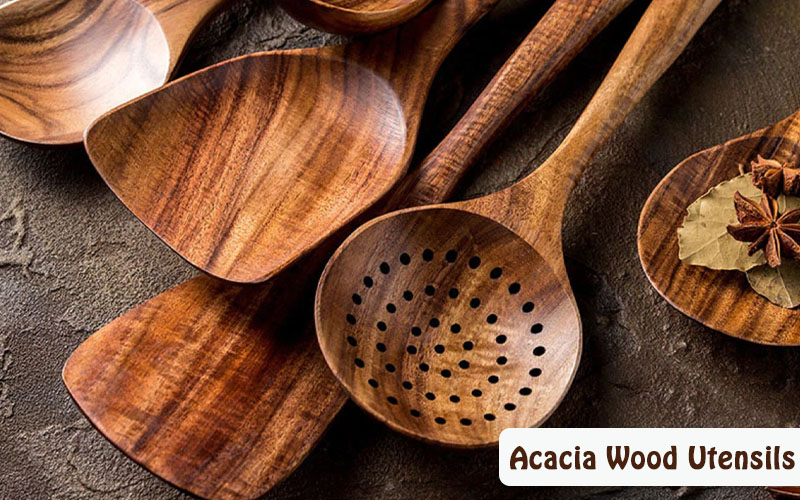Neither the woods that are considered holy nor the ones that are known for their hardiness lose their importance.
From tree to timber, timber to lumber, and finally to furniture or fossil fuel – they serve us purposefully.
But in the case of olives, both lumber and fruit are equally important. In fact, we are so obsessed with reading the benefits of olives that its amazing wood gets ignored.
So, today we are going to shed some light on none other than Olive Wood. Keep reading, as you will have much more to tell about this wood once you read it.
Let’s begin!

Table of Contents
1. Olivewood Is An Exotic Wood with Unique Features
As olives and olive oil hold a prestigious place when it comes to healthy food, the wood obtained from its tree is famous as well.
Let’s look at what wood is olive wood.
What Is Olive Wood? How To Identify Olive Wood?
Olive wood is the cream to golden wood obtained from the olive trees (Olea europaea) having fine uniform texture, natural shine, with straight, interlinked, or widely patterned grain.
It’s native to Southern Europe, Eastern Africa, and the Middle East.
It’s one of the hardest woods, famous for making high-end kitchenware, religious scriptures, small furniture, or simply kept as blanks for decoration.
What’s Unique About Olive Wood (Olive Wood Properties)?
- It’s a sustainable wood – just branches are pruned using hand held circular saw instead of cutting down the centuries-old trees.
- It’s hard-to-dry wood that often warps if not dried with a slow drying method like the Kiln-drying process.
- It has a fruity scent when chopped and worked on.
- The color turns from yellowish-brown to dark brown as the tree becomes old.
- The logs or olive wood lumbers are not too big because the average olive tree height is 20-30 ft.
- Olivewood is not super durable as it cannot withstand termite attacks.
- The olive tree can grow from the stumps as Crepe Myrtle plants do.
- The grain pattern is mostly swirling because the trunks are not completely round.
- Regarding the hardiness, it’s categorized among the hard and strong woods, although lesser in strength than the mighty acacia wood.
Types of Olive Woods
Mainly we can categorize olive trees into two types.
Those grow in the Mediterranean, called Olea Europaea, and the ones that grow in Eastern Africa, known as Olea Capensis.
2. Olivewood Makes High-end Furniture and Kitchenware
- Olive Wood Cutting Board

- Olive Wood Serving Bowl

- Olive Wood Coffee Table

The furniture and utensils made from olive wood are not ordinary. In furniture, you would rarely find olive wood beds, cupboards, etc.
The woodware you would commonly found made from olive wood are small ones, including sculptures, kitchen utensils, and decorative pieces.
Here are some of the beautiful olive wood-made furniture.
What is Olive Wood Good for? (Uses of Olive Wood)
The furniture made from olive wood is not ordinary. Rather it’s pretty expensive, for the beauty of its grains, hard-to-break feature, and for being less porous.
You won’t see big furniture products made of olive wood because of its high cost.
The most common wood items made from olive wood are kitchenware – especially cutting boards, bowls, and carving spoons – decorative items, small chest of drawers, tool-handles, jewelry, and hand-carved material.
Why is olive wood used for making bowls and utensils? It’s because olive wood is durable than most other woods, and it’s stain and odor-resistant.
However, on the darker side of it, it is prone to termite attacks.
A 1000 or higher Janka Hardness rating is considered acceptable for any wood which is going to be used in tough places, like flooring.
3. Olive Wood Is Considered Holy
In addition to olive wood’s primary use, it’s considered holy according to some heavenly scriptures.
What Does Olive wood symbolize? Compiling the old scriptures, religious texts, and history of olive trees, we can say an olive tree symbolizes peace, livelihood, tree of life, beauty, longevity, legacy, and healing.
In the Bible, olive trees are symbolized as fertility and prosperity. In the Old Testament, it’s called a symbol of peace while referring to Noah’s story.
According to the Bible, it was the freshly plucked olive leaf that the dove returned with before Noah sent her to find if the water had receded – indicating the end of God’s anger.
What is Bethlehem Olive Wood?
- Olive Wood Hand-made Holy Scriptures

- Olive Wood Hand Made Cross

Olive wood is a sacred wood obtained from some of the oldest olive trees in Bethlehem city, the city of Jesus Christ’s birth and known as the cradle of peace.
Olive trees grow in other parts of the Holy Land as well, like Jerusalem and Nazareth, but the Bethlehem olive wood holds its importance.
Why? Primarily because Bethlehem has the oldest olive trees. The older an olive tree, the more grains and smooth texture it has.
Other reasons include Jesus Christ is believed to have prayed under an olive tree before he was crucified.
Seeing the sacredness of olive wood, the artisans at Bethlehem make religious, historical, and artistic articles from the prunes of young olive branches
4. Olive Wood is Expensive & Needs Due Care
Olivewood is one of the few kinds of wood that is sold online – as pen blanks, slabs, blocks, bowl planks, or logs.
And when it comes to the handicrafts of olive wood, it’s too diversified and large-scale. Some of them include crosses & crucifixes, rosaries, jewelry, tableware, desk ware, nativity sets, figurines, ornaments, kitchenware, plaques, etc.
Tips for taking care of the Olive Wood Accessories
Since you have one of the best handicrafts or kitchenware made of olive wood, it’s time you get to know how to take care of them.
- Wash with warm water and dry with a lint-free cloth.
- Once washed, apply a thin coat of any mineral oil and let it dry. Repeat this once more. (Do it once a month)
- Do not ever put your olive utensils in a dishwasher.
- Avoid soaking it in water for long hours, as it will weaken the wood causing it to rot or fall apart.
5. Olive Wood Stands Out Among Other Woods
Let’s look at an image comparison of olive wood utensils with other popular woods.
1. Old Wood Utensils

The olivewood is unique for its wavy or curly grain that does not certainly follow a pattern, and this is what makes it beautiful. Have a look at the following kitchenware.
2. Acacia wood

Acacia wood, on the other hand, has many straight uniform grains, and most importantly, its waterproof and difficult-to-break features make it unique among all other woods.
Take a look at a few of the spoons made of this tough wood.
3. Bamboo Wood

Since it’s from the grass family, there are no visible grain patterns or growth rings. The texture is uniform and consists of almost straight lines with a slight change in the shade.
It’s the cheapest wood in the kitchenware category.
4. Maple Wood

Maple is also one of the hardest woods known as having a fine, uniform texture with straight grains with a little variation. The thin line patterns make this wood undeniably beautiful.
Take a look at the following utensils made of maple wood.
The Bottom Line
Being known as the hardest woods, Olive Wood is symbolized as peace, longevity, and sacredness, etc. Its beautiful and messy grain patterns – straight, interlocked, or wild – is what makes it high-demanding.
The olive wood from the trees of Bethlehem is considered holy for Christians around the world.
From cutting boards, serving bowls, small furniture to carved religious scriptures, olive wood is extensively used worldwide.
Do you own or have plans to buy any product made of olive wood? Let us know about your review of this tough and elegant wood.


I enjoyed reading through this article. I’ve used olive wood kitchen utensils for years and another note worth mentioning is that olive wood has a high heat tolerance. I can leave the handle resting on the edge of the pan on any type of cookware (stainless steel, cast iron, etc) and I’m yet to see any discoloration or signs of distress from heat on any kitchen item I have. The olive wood aesthetic really is unique by each piece and are the most beautiful items we use in our kitchen!